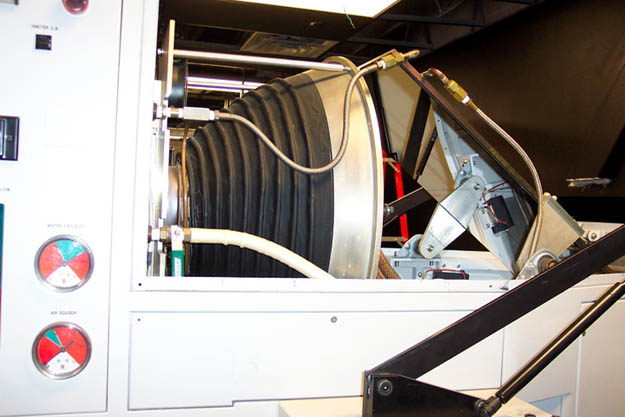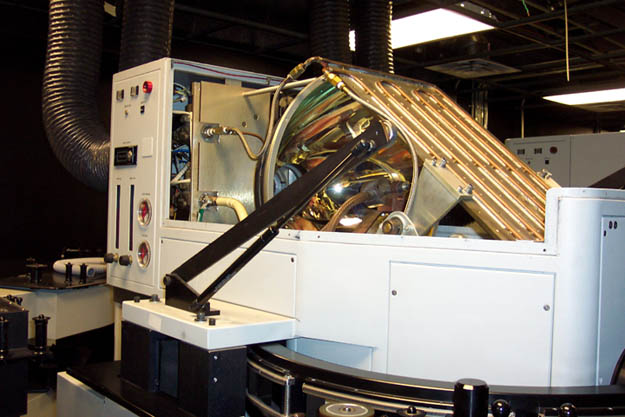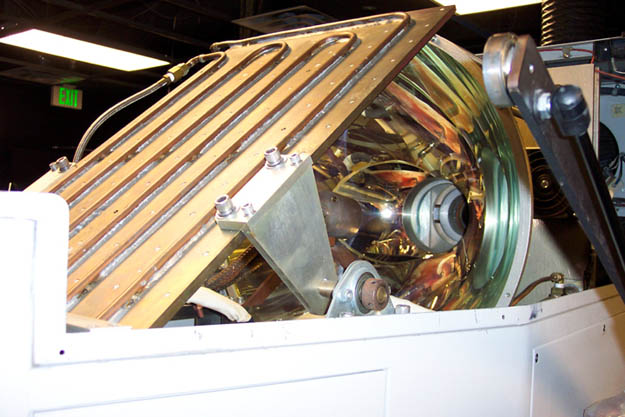IMAX
IMAX is a motion picture film format
and a set of proprietary cinema projection standards created by the
Canadian IMAX Corporation. IMAX has the capacity to record and display
images of far greater size and resolution than conventional film
systems. Feature films have traditionally been upconverted into IMAX
format for display in IMAX theatres, though some have been partially shot in IMAX.
A comparison between 35 mm and 15/70 mm negative areas
IMAX is the most widely used system for special-venue film
presentations. As of September 2010, there were more than 445 IMAX
theatres in 47 countries.


Film
IMAX uses "ESTAR" (Kodak's
trade name for PET film) base. The reason is for precision more than
strength. Developing chemicals do not change the size or shape of ESTAR,
and IMAX's pin registration (especially the cam mechanism) does not
tolerate either sprocket – hole or film – thickness variations. The IMAX
format is generically called "15/70" film, the name referring to the 15
sprocket holes per frame.

The film's bulk requires platters
rather than conventional film reels. IMAX platters range from 1.2 to
1.83 metres (3.9 to 6.0 ft) diameter to accommodate 1 to 2.75 h of film.
Platters with a 2.5 hour feature film weigh 250 kilograms (551 lb).
Projectors
The 15 kW Xenon short-arc lamp used in IMAX projectors, the GT 3D projector (dual rotor) used two!
 |
Its operating voltage is 37.5 volts
with a current consumption of 400 amps (3D 800 amps). At an operating
temperature of approx. 700 degrees C, up to 1.6 cubic metres (3D 3.2
cubic meters) of air and 36 litres (3D 72 litres) of distilled water per
minute are fed through the lamphouse, to cool down the xenon gas
discharge lamp. The lamp is very expensive.
One tells that the cost is
approximately 6000 US dollars (3D 12000 US dollars), which is
approximately 4400 Euros (8800 Euros). It should last 1000-1200 hours.
|

GT 3D projector (dual rotor) Water cooled reflector for the left eye projection

GT 3D projector (dual rotor) Water cooled mirror for the left eye projection


GT 3D projector (dual rotor) Water cooled mirror for the right eye projection
Drawing the large film through the
projector presented challenges for both the camera and the projector.
Conventional 70 mm systems were not steady enough for the 586×
magnification. On the projector side, William Shaw adapted an Australian
patent for film transport called the "rolling loop"
by adding a compressed air "puffer" to accelerate the film, and put a
cylindrical lens in the projector's "aperture block". The projector uses
a vacuum to pull the film into contact with this lens. This the "field
flattener" flattens the image field. The lens is twice the height of the
film and connects to a pneumatic piston so it can be moved up or down
while the projector is running. This way, if a piece of dust comes off
the film and sticks to the lens, the projectionist can switch to the
clean side of the lens at the push of a button.
 |
The lens also has "wiper bars" made of a felt or brush-like material which can wipe dust off the lens as it moves up or down. IMAX projectors are pin stabilized, meaning four registration pins engage the perforations at the corners of the projected frame to ensure perfect alignment. Shaw added cam–controlled arms to decelerate each frame to eliminate the microscopic shaking as the frame "settled" onto the registration pins. The projector's shutter is open around 20% longer than in conventional equipment and the light source is brighter. |
The xenon short-arc lamps are made of a
thin layer of fused quartz and contain xenon gas at a pressure of about
25 atmospheres (367 PSI); because of this, projectionists are required
to wear protective body armor when changing or handling these in case
the lamp breaks (e.g., due to a drop to the floor) because of the danger
from flying quartz shards when propelled by the high pressure of the
Xenon gas within.
An IMAX projector weighs up to 1.8 t (2.0 short tons) and at over 178 cm (70 in) tall and 195 cm (77 in) long.
 |
Double projection with two IMAX
15Perf/70mm films running from the right to left site of the projector.
Please note the volumious service connections for the water- and air
cooling supply.
IMAX
projectors are the most advanced, precise and powerful projectors that
have ever been made. Their image quality and reliability is based on an
ingenious solution for the transport of the film, the so-called "rolling
loop".
|
IMAX Corporation has released
four projector types that use its 15-perforation, 70 mm film format: GT
(Grand Theatre), GT 3D (dual rotor), SR (Small Rotor) and MPX,
which was designed for retrofitted theatres. In July 2008, the company
introduced a digital projection system, which it has not given a
distinct name or brand, designed for multiplex theatres with screens no
wider than 21.3 m (70 ft). All IMAX projectors, except the standard GT
system, can project 3D images.
 |
70mm IMAX film (here lying flat in the upper rolling loop drum) in front of the image aperture glass which is opened to the right for film access, which can only be seen from above (edge) on the right here. | |
 |
The 70mm IMAX film is pulled out. Top left, light from the xenon gas discharge lamps can be seen. In front of this is the upper rolling loop drum with an indentation (there is a total of 8 per drum) for the film loop. In one indentation exactly fits one IMAX 15Perf/70mm piece of film. | |
 |
Here on the left, the image aperture glass that has been opened forwards. In front of this are the two rolling loop drums for the bottom and top film runs, with the openings for the lights of the two projection lamps illuminated in blue. | |
 |
Running double projection through polarisation filters. The vertical projection gates in front are destined for the projection of 2D films. | |
In this report I have attempted to
describe how the best possible - but also most expensive - analogue 3D
presentation could be achieved in cinemas using 70mm film and how it is
still used today with IMAX.
Soundtrack
 |
The 35mm sound dubber with 6 channel magnetic IMAX sound. To the left all the amps are located.
I
will try to describe how the audio system works, from projector to the
audience. Sound for an IMAX or IMAX Dome film program historically has
been supplied on 35mm sprocketed magnetic film which runs at 90 feet per
minute (45.7 cm/sec.). The sound reproducer, often called a dubber, is
located in the projection room.
This
multi channel playback unit was originally developed for film studios
where banks of them are used when mixing sound tracks. It provides
exceptionally high quality sound reproduction and feeds the six channel
system plus sub-bass through IMAX TAC-86 multi channel audio control
computer. Maximum playing time is one hour with a reel capacity of 5000
feet (1500 m).
An
interlock circuit between the projector and the reproducer maintains
frame-to-frame synchronization of projected picture and sound. A rotary
shaft encoder required for synchronizing audio reproduction is installed
in the IMAX projector.
|
Most newer IMAX films are now using
the IMAX digital sound DDP designed by Sonics. DDP is short for Digital
Disc Playback. The system is a digital sound source specifically made
for IMAX. Sonics uses compact disc technology to create the highest
quality sound delivery possible today. Wide frequency response, dynamic
range and the accurate perception of time are the attributes of DDP. A
frequency response of 20 – 20.000 Hz is maintained over the entire audio
spectrum of ten octaves. Six octaves is found in conventional cinemas.
 |
Three CD’s are used for each
soundtrack, one CD for every 2 channels. The audio is sent to the Sonics
TAC-86. From the TAC-86 the signal is sent to the computer-controlled
1/3 octave equalization unit, developed for IMAX. This unit matches the
sound system performance to suit the acoustics of the particular theater
in which it is installed. The equalization can also be used to
compensate the response of particular films for optimized playback in a
particular theater.
 |
Behind the screen
Imax theatres require a sound
system able to produce believable effects and operate reliably at
unusually high power levels. The Imax sound system by Sonics provides
extremely high sound quality that does full justice to the unique film
presentation. A Sonics sound system operates in an environment which is
quite different acoustically from most other theatres. The Imax film
program depends on the optimum performance of the combined projector and
sound system to achieve maximum audience impact.
In
1988, Imax acquired Sonics Associates Inc. as an affiliate. Alabama
based Sonics is a world leader in sound system design and offers
customers the benefits of more than 26 years of research and hands-on
experience in the IMAX theatre network.

 |
After the equalization, the signal
is sent to the power amplifiers. The amps deliver more than 2000 watts
per channel. The entire system is more than 15000 watts. The six audio
channels are fed to a 4-way JBL speaker array. Every section is equipped
with JBL models no: 2404 H (Ultra-High Frequency), 2445 J (Wide Range),
2123 H (High Power Low Frequency), and 2245 H (Medium Efficiency
Extended Bass). They are located to give strong directional effects and
placed as follows: Channel 1 Left rear (theater), Channel 2 Left screen,
Channel 3 Center screen, Channel 4 Right screen, Channel 5 Right rear
(theater), Channel 6 Top of screen.
|
The
group of sub-bass speakers, located at the front of the theater behind
the screen, is fed a mix of low frequency sound derived by the TAC-86
from all six channels. The power amplifier for sub-bass is more than
3000 watts. The price for the Sonics sound system is more than 300,000
$. After many
years of work with Sonics sound system, there has never been one
complaint about the sound system, except maybe that it is too loud. I
have listened to the system many times with hi-fi enthusiasts, and they
always say it is the best cinema system they have heard. Because of the
enormous power you can always hear all details.


No comments:
Post a Comment